New Orleans: 125,000 still missing post Katrina
Five years ago Hurricane Katrina engulfed New Orleans. Jennifer Rigby speaks to residents, charities and officials about rebuilding efforts as President Obama visits the city to mark the anniversary.
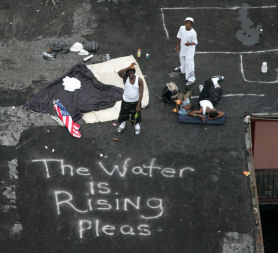
“Laissez les bon temps rouler” — “let the good times roll” — is the unofficial motto of the city of New Orleans, in the American south.
But in recent years, the good times have been thin on the ground for the city.
Five years on, it is still recovering from the devastating floods that swept through the city in the wake of Hurricane Katrina, one of America’s worst ever natural disasters.
President Barack Obama paid tribute to the victims of the flooding in a speech in New Orleans on Sunday night, on the anniversary of the catastrophe. He also hailed recovery workers and the resilience of the city’s population, saying: “Because of you, New Orleans is coming back.”
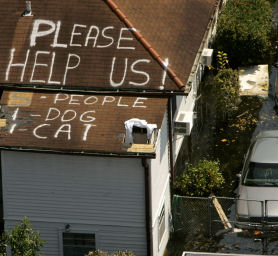
He said his government would continue rebuilding “until the job is done”, and criticised the “shameful breakdown” of the previous administration in the immediate aftermath of the hurricane.
Ceremonies across the city marked the anniversary.
Damage and devastation
Official estimates suggest 1,836 people died in Hurricane Katrina, and more than $81bn of property was damaged.
The majority of the city’s population fled and more than 125,000 people have never returned to the city, 80 per cent of which was affected by the flooding caused mainly by the Mississippi river breaching its banks after the storm.
Some areas were completely submerged under 20 feet of water and the watermarks remain on some walls of some houses.
And while lots of areas in New Orleans – including its touristic heartland of the French Quarter – are basically back to normal, and others are being rebuilt, in some areas it can still feel like a ghost city.
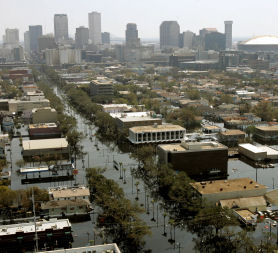
Abandoned areas
One local resident told Channel 4 News the New Orleans East area is still almost completely abandoned. It used to have a population of more than 100,000, but only 7,000 have returned, he said.
The government was lambasted for its slow response to the catastrophe as reports of looting and devastation emerged in the days after the flood. Months later, areas of town were still patrolled by the US army, and other areas were cordoned off.
When we got back here after Katrina, my wife fell to her knees and cried for a full hour. New Orleans taxi driver John Gasper.
Five years – and billions of dollars of recovery money, and hundreds of individual stories – later, the ongoing recovery from such a massive disaster is a mixed, and controversial, picture.
“When we got back here after Katrina, my wife fell to her knees and cried for a full hour,” taxi driver John Gasper told Channel 4 News.
“Our whole house was destroyed. Our front door was kicked in. Everything was lost.”
Mr Gasper lived in St Bernard’s Parish, one of several which were particularly badly hit. He left the city after the storm, and was unable to return permanently for a year and a half. Even then, it took a further eight months to rebuild his home.
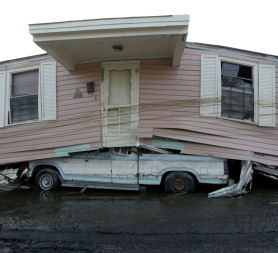
He did so with the help of the city’s “Road Home” programme. The scheme gave financial help to families trying to get back home to New Orleans and rebuild their lives. It has faced criticism for its excessive bureaucracy, but for Mr Gasper, it worked.
“We took what insurance money we could get and the money we had, and fixed the house up. If it wasn’t for having good credit…Three years later, we had everything paid for, which felt good,” he said.
Some amazing progress
He thinks the city is doing well in rebuilding – and certainly in some parts of New Orleans there has been amazing progress.
The Lower Ninth Ward was one of the most badly damaged areas in the flood. Entire roads disappeared, and there remain hundreds of empty plots which used to be people’s homes.

However, the Lower Ninth Ward has also become New Orleans’ poster boy for recovery.
The Make It Right Foundation, backed by Brad Pitt, is one of a number of charities working in the area. It has built 14 architecturally acclaimed, but affordable homes, and is aiming to build 150 in total.
Common Ground Relief, led by Thomas Pepper, is another charity helping residents of the Lower Ninth Ward, many of whom lost everything.
We still get hundreds of volunteers every year from across the country. Thomas Pepper, leader of charity Common Ground Relief
Before the flood, the area had one of the highest numbers of black homeowners in the US. Now Mr Pepper and his volunteers are working with people whose homes were destroyed.
Five years on, they are still busy.
“We still get hundreds of volunteers every year from across the country,” he told Channel 4 News. “We have a skilled volunteer base that offers help to people and reduces the price of a home for people who are trying to get back on their feet.”
One of the houses they have rebuilt is owned by Smitty, a former radical coffee shop chain owner.
“When you see what they have done here, you will be really elated,” he said.
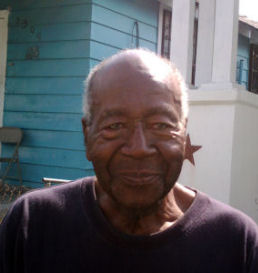
'We have lost the life we had here before'
"I grew up here. Katrina devastated my house. It took me four and a half years to get back in, and I only did it with the help of [charity] Common Ground Relief," Lower Ninth Ward resident Smitty told Channel 4 News.
"We had 18ft of water. We have lost the life we had here before. Even if we get the buildings back to how they were, everything has changed.
"Fats Domino used to live down the block. He's not come back. The people who lived behind me - they are too old to work their way back here. Their house is empty.
"It's changed here. But new people are coming in and that's what we desperately need.
"When we were rebuilding my house, the dry walling was ripped out three times. In spite of all these mishaps, the guys from Common Ground Relief said – we are with you all the way.
"When you see what they have done here, you will be really elated."
Smitty, a resident of the Lower Ninth Ward, saw his house partially destroyed by Katrina. He has rebuilt it with the help of charity Common Ground Relief, and moved in March this year.
Mr Gasper also encourages people to come and see the positives in New Orleans.
“We want people to come and see us now, and see that we are survivors,” he said. “When you give New Orleans people lemons, they make lemonade.”
When you give New Orleans people lemons, they make lemonade. John Gasper, New Orleans taxi driver.
For some people though, that lemonade will still leave a bitter taste. While Mr Gasper and Smitty have rebuilt their lives and homes, many in New Orleans – always a poor city – found that too daunting a task.
A fifth of city’s population still missing
A recent report by the Greater New Orleans Community Data Centre and the Brookings Institution found New Orleans is still missing a fifth of its people. More than 125,000 have never returned.
And while lots of areas in New Orleans – including its touristic heartland of the French Quarter – are basically back to normal, and others like the Lower Ninth Ward are being rebuilt, in some areas of the city it is as though the flood waters have only just subsided.
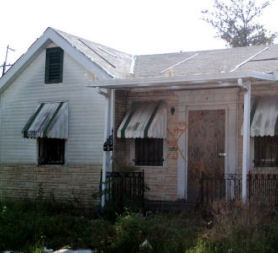
One local resident told Channel 4 News about the problems of the New Orleans East area, which he said used to have a population of more than 100,000. His estimate is that only 7,000 people have returned, partly because of a complete lack of recovery of the area’s amenities.
Vast buildings, including hospitals, churches and retail parks, were washed away or damaged and remain empty. They line the main road through town in an eerie parade. The area’s schools remain closed, and only five of its 250 restaurants have reopened.
The recession, followed by the recent Gulf oil spill, has not helped matters.
But it seems that, five years on, individuals like Smitty and Mr Gasper are managing to get their lives back on track. Thousands of homes have been rebuilt. However the local government has been a little slower to respond on a larger scale, leaving tens of thousands of blighted structures. One local property developer estimated that 60,000 structures remain abandoned in New Orleans.
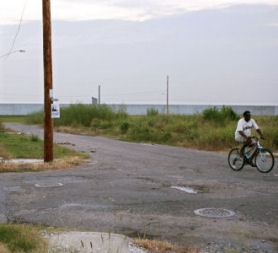
Master plan?
Tom Murphy, senior research fellow at the Urban Land Institute, agreed that there has been a lack of leadership in New Orleans, but said this was a natural pause in the face of a disaster of this scale.
“When my father died, it took me two years to get around to cleaning up his house and selling it,” he told Channel 4 News.
“People in New Orleans were grieving like that.
“It has taken them five years just to clean up the city, and deal with the psychological impact of living through that.”
Mr Murphy said there are five “master plans” to regenerate New Orleans – none of which take into account how they could ever be delivered.
Now there is leadership
"When my father died, it took me two years to get around to cleaning up his house and selling it. People in New Orleans were grieving like that," Urban Land Institute senior researcher Tom Murphy told Channel 4 News.
"It has taken them five years just to clean up the city, and deal with the psychological impact of living through that. But I think New Orleans is poised to have a renaissance.
"There are five master plans: someone needs to take that and make it real. On paper, they are pretty pictures, but within the plans, the reality is, what is available, which properties are tax delinquent, abandoned, and a strategy on how to get them, how to finance them, and how to get people to live in them.
"New Orleans has a unique charm that will attract people, but it will be a smaller city than before. It has had five years to deal with the grief, and look at master plans with no real leadership: now, with the new mayor, there is leadership and investment can come in if the mayor can make the right atmosphere for it."
Tom Murphy is senior researcher at the Urban Land Institute, and has spent a lot of time in New Orleans working on how the city can recover after Hurricane Katrina.
In the meantime, the city has a young lawyer from New York called Omeed Sathe.
He is the director of real estate strategy at the New Orleans Redevelopment Authority. And while the upper echelons of the city’s government argue over the master plans, Mr Sathe is getting on with it.
People feel like nothing is being built on the scale of what happened. But we are doing something. Omeed Sathe, head of real estate at the New Orleans Redevelopment Authority.
He is in control of the redevelopment of 5,000 properties which were sold back to the state after Katrina. It has taken five years to close the transactions to get hold of the scattered sites all around New Orleans – but now it is time for action.
Mr Sathe told Channel 4 News: “People feel like nothing is being built on the scale of what happened – 80 per cent of the city was damaged in some way. But we are doing something.”
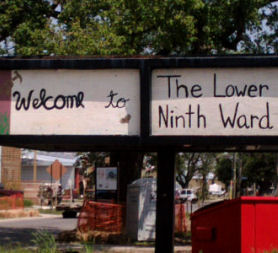
Because the cost of rebuilding is higher than the value of the completed properties will be, this is not a job for private companies – yet. Mr Sathe hopes that it one day will be, and areas like the Lower Ninth Ward will thrive again.
“It’s a challenge. These properties are located in once stable communities, but after the storm they are not stable,” he said.
“They were 96 per cent occupied, and now they are 50 per cent occupied. We own probably 5-10 per cent of any neighbourhood – not enough to redevelop the whole neighbourhood.
“We have to fill these neighbourhoods up. The aim is to get values up so that people can come in and invest and we can get the hell out,” he said.
A photogenic disaster - but recovery is not so easy to document
"This was an incredibly photogenic disaster. It's a bit of a bizarre way to put it but the scenes of devastation, the slow pace at which it took place, the futility of the response, was an incredible media event.
"Recovery is one of the least photogenic processes. Largely what it consists of is individuals rebuilding their own properties, groups fixing a few properties up on a block, that pattern repeated on 10,000 blocks.
"Part of the challenge is lots of people feel like nothing is being built on the scale of what took place. But if you know where to look – 80 per cent of the city's housing stock was damaged in some way, and a massive amount of that has been rehabilitated.
"The city went through this extraordinary master planning process – the tab came back at $14bn. They had about $1bn. What good is a plan if it is not planned against financial constraints?
"Planning is too often imagining, it's not a tool by which you can make tough decisions. Where we sit is...because the master plan is so big, we have the land and pots of money, what gets pulled from the master plan is often decided by our decisions. Often we go back to the neighbourhoods and have those complicated conversations and say: 'Ok, you wanted a pony, you wanted a unicorn, you wanted a saddle. We'll give you one of the three."
Omeed Sathe is head of real estate strategy at the New Orleans Redevelopment Authority.
There is some large scale development happening in New Orleans.
Major projects
The city has four major projects under way, to rebuild four huge social housing complexes in partnership with private developers.
These are also not without their controversy – some have suggested that rebuilding the projects from scratch was unnecessary, and more of a form of social engineering than a rescue operation.
A report from university MIT found that one of the projects which is being completely demolished and rebuilt only suffered “minor” damage.
However, one man who appears unconcerned by the controversy is Warren Buffett, third-richest man in the world, who has pledged his support to one of the four projects.
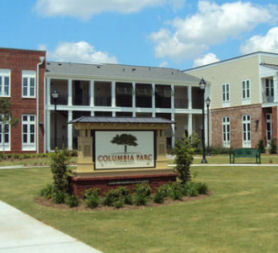
He is backing the $425m redevelopment of a former crime-riddled estate into a “mixed-income” community.
Buffett’s Purpose Built Communities, founded with developer Tom Cousins and philanthropist Julian Robertson, pioneered a similar model in East Lake, Atlanta, Georgia.
Buffett’s organisation is now affiliated with those which are working together to undertake a similar project in New Orleans, led by the Bayou District Foundation and Columbia Residential.
The project is located at the former St Bernard Housing Community, now re-named Bayou St John, and the first phase opened in spring.
It includes housing and a host of amenities, from a swimming pool to a theatre to schools, for the residents. People moving into the flats will be a mixture of those whose rent is paid completely by the state and those whose rent is partly paid – both “social housing” tenants – and those paying the full market rate. The rental levels will depend on the residents’ incomes.
Developer JT Hannan says they aim to “switch the paradigm” of low income housing.
But the Atlanta scheme has hit some bad press in the United States over its tough rules, such as not allowing residents with a criminal record to move back into the housing.
A grandmother whose grandson brought a gun onto the development in Atlanta was also evicted.
“You have rules, and rules are there to be obeyed,” said Mr Hannan, citing the success of the Atlanta scheme at bringing its residents out of poverty.
It is understood that similar rules will apply to the New Orleans scheme – former residents will not be allowed to return if they have criminal records, and will be evicted if they commit crime when living in the development.
Whatever your thoughts on this Truman Show-style project are, it is at least a sign of something positive happening on a grand scale in the redevelopment of New Orleans.
What does the future hold?
And it is not the only one. All of the residents Channel 4 News spoke to – from cab drivers to academics – said they felt more optimistic about New Orleans’ future now than at any point since Katrina.
In June, the Kaiser Foundation surveyed more than 1,500 New Orleans residents on their opinions over the recovery.
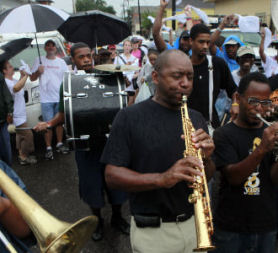
While they continued to be worried about issues like crime and corruption, two-thirds said their lives were back to normal, and 70 per cent said they felt the rebuilding process was going in the right direction.
There are several reasons for this — from the election of a new mayor, Mitch Landrieu, who took office in the spring, to the joy that erupted across the city at the end of last year, when the New Orleans Saints won the Super Bowl.
At 6pm tonight, the mayor will lead a memorial to the lives lost and a celebration of the city’s determination and resiliency in the city’s famous Jackson Square.
So – to put it in resident Mr Gasper’s terms – while there’s still lemons, more and more of them are being turned into lemonade, five years on from Hurricane Katrina. But there’s a long way to go yet.
Watch: Jon Snow reporting from New Orleans after Hurricane Katrina and the floods, in September 2005.